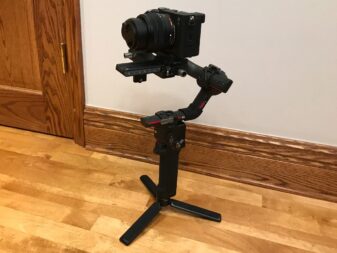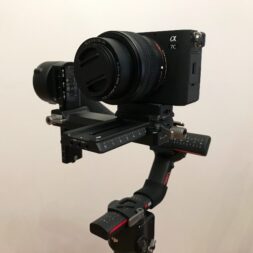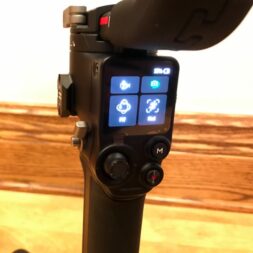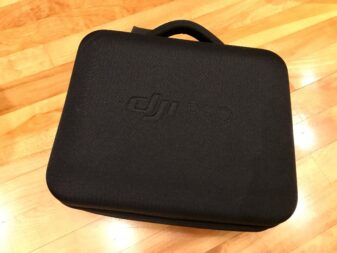 Filming very smoothly is a very tricky thing. This is especially true if it’s an action sequence. In the past, stabilizers were expensive tools that only big studios could afford. Thankfully, this has changed and the price of entry is much lower. Nowadays, it’s possible to get Hollywood-worthy material without breaking the bank thanks to companies such as DJI. Their Ronin series is one of the most popular lines of lightweight gimbals on the market. Recently, they have released the RS3 Pro, a top-of-the-line camera stabilizer that will interest the most demanding users. Keep reading to find out what has been improved and how it compares to the regular RS3.
Filming very smoothly is a very tricky thing. This is especially true if it’s an action sequence. In the past, stabilizers were expensive tools that only big studios could afford. Thankfully, this has changed and the price of entry is much lower. Nowadays, it’s possible to get Hollywood-worthy material without breaking the bank thanks to companies such as DJI. Their Ronin series is one of the most popular lines of lightweight gimbals on the market. Recently, they have released the RS3 Pro, a top-of-the-line camera stabilizer that will interest the most demanding users. Keep reading to find out what has been improved and how it compares to the regular RS3.
First of all, make sure to check out this video that documents my impressions after using the RS3 Pro for the first time. It also features some footage I shot with my friend and filmmaker Charlie Sporns.
A gimbal for larger bodies and lenses
 One of the main selling points of the RS3 Pro is the fact that it can accommodate larger camera bodies and lenses. The area between the arms is a lot bigger compared to the other Ronin models. Bodies that are compatible include the Red Komodo, Blackmagic BMPCC, Sony FX6 or FX3, and additional models you can find on DJI’s website. The tested payload is 4.5 kg (10 lbs), which is 50% more than what the other gimbals can handle.
One of the main selling points of the RS3 Pro is the fact that it can accommodate larger camera bodies and lenses. The area between the arms is a lot bigger compared to the other Ronin models. Bodies that are compatible include the Red Komodo, Blackmagic BMPCC, Sony FX6 or FX3, and additional models you can find on DJI’s website. The tested payload is 4.5 kg (10 lbs), which is 50% more than what the other gimbals can handle.
Another unique feature is the focusing system that works with LiDAR. This technology measures distances with the help of a laser. In this case, it helps to the camera to better target a moving subject. This offers very precise focusing, that couldn’t be achieved while operating a gimbal. It’s particularly useful in action sequences that have a lot of movement. You’ll be able to concentrate on getting the perfect shot, without worrying about focusing as much. The only drawback is that it will drain the battery very fast. You’ll also need to purchase the LiDAR Range Finder from DJI for it to work.
Several improvements from the previous generation
 As it was the case with the RS3, the RS3 pro incorporates DJI’s 3rd generation stabilization algorithm. This is an enhanced version of the one present on the RSC 2 and offers even smoother shots than what was possible before. Super smooth mode is available, delivering more torque to the arm motors for an even more stable image.
As it was the case with the RS3, the RS3 pro incorporates DJI’s 3rd generation stabilization algorithm. This is an enhanced version of the one present on the RSC 2 and offers even smoother shots than what was possible before. Super smooth mode is available, delivering more torque to the arm motors for an even more stable image.
The touchscreen was enhanced with an OLED colour display, as well as a larger 1.8-inch surface. This is a big improvement from the small 1-inch, black and white screen present on the RSC 2.
The battery is now removable in the RS3 Pro. Although it has a generous runtime of 12 hours, you might use it up faster with LiDAR and supersmooth mode. It’s good to know that your shoot won’t be compromised thanks to a quick battery change.
Lastly, the axis locks are now automated. When you boot up the gimbal, everything jumps into place, letting you start filming in no time. Once you’re done, you can power down and the arms will fold back into a compact format for transport.
Streamlined balancing and calibration
 Balancing your camera and calibrating the RS3 Pro is an important part of the setup. It’s not a very long process, once you get the hang of it. DJI made everything as easy as possible, especially with the addition of a new fine-tuning knob for the main camera plate. It makes the most finicky part of balancing very easy and precise. Calibration is automatically done by the gimbal itself, so you can start filming quickly.
Balancing your camera and calibrating the RS3 Pro is an important part of the setup. It’s not a very long process, once you get the hang of it. DJI made everything as easy as possible, especially with the addition of a new fine-tuning knob for the main camera plate. It makes the most finicky part of balancing very easy and precise. Calibration is automatically done by the gimbal itself, so you can start filming quickly.
Easy to use
Using the RS3 Pro is similar to the other models in the Ronin line. There’s a trigger that will lock the camera in place when you hold it. You can then move it with the joystick for slight adjustments. Double tapping the trigger will reset the position back to where it was balanced. Triple clicking will turn the camera around for selfie mode; perfect for vloggers.
 There is a toggle switch that lets you select which axes will pivot. These include pan, tilt, and roll. You can also customize one of the switches to activate portrait mode, 3D roll 360, or a custom setting that you can edit in the accompanying app. There are many other parameters to edit in the app and you’ll be able to set the gimbal to suit your movements. There are even several user profiles to use with different camera operators or for various situations.
There is a toggle switch that lets you select which axes will pivot. These include pan, tilt, and roll. You can also customize one of the switches to activate portrait mode, 3D roll 360, or a custom setting that you can edit in the accompanying app. There are many other parameters to edit in the app and you’ll be able to set the gimbal to suit your movements. There are even several user profiles to use with different camera operators or for various situations.
The gimbal is bit bigger than the other models of its line, so it weighs a bit more. When you take into account the larger cameras it was built for, it can add up, even though the arms are made out of carbon fibre. This is something you’ll have to take into account, especially on long shoots. It can get tiring holding the loaded stabilizer for extended amounts of time.
While it’s easy to use once you get acquainted with its buttons, there is a slight learning curve with operating a gimbal. I suggest you practice balancing it a few times at home so you can do it quickly in any situation. Also, operating it well requires a bit of experience, so make sure you take it out for a spin before going on an important shoot.
Great results, niche features
 If you are looking to produce silky smooth images, you can’t go wrong with any of the DJI products. They offer excellent value for money and also consistent, excellent results. They are easy enough to set up and use, but also let you customize a lot of different parameters to improve your workflow. It’s a great tool to give your shots a nice, polished look.
If you are looking to produce silky smooth images, you can’t go wrong with any of the DJI products. They offer excellent value for money and also consistent, excellent results. They are easy enough to set up and use, but also let you customize a lot of different parameters to improve your workflow. It’s a great tool to give your shots a nice, polished look.
In the case of the RS3 Pro, the added features are rather niche and targeted at a certain type of user. If you don’t plan on purchasing the rangefinder to benefit from the LiDAR auto-focusing and if you don’t have one of those larger cameras mentioned above or on the website, you might as well go with the less expensive RS3. From my review of the RS3, I can say the results are equally impressive.
Make sure to check out the DJI RS3 Pro camera gimbal on Best Buy’s website.



